|
|
|
|
|
|
|
Curacao
|
|
|
|
|

|

|
|
|
|
|
|
|
|

|

|
|
|
|
|
|
|
|

|

|
|
|
Coming Soon!
|
|
|
|
|

|

|
|
|
Coming Soon!
|
|
|
|
|
|
|
|
|
|
|
Our FREE Newsletter keeps you up to date on:
- Last Minute Deals
- Limited Space Specials
- Latest Travel News
- And More!
|
|
|
|
|
|
|
|
|
|
|
|
Flash Links
|
|
Your quick link to the most popular pages on our site!
Just click below and go!
|
|
|
|
|
|
|
|
|
|
Resort Vacations
|
|
|
|
|
|
|
|
|
|
|
|

|
|
Hospitable and always sunny, Curacao bids you a warm welcome. The friendly inhabitants, first class hotels, wonderful climate, crystal clear seawater, fascinating architecture, floating market, pontoon bridge, secluded bays, rich fauna and flora, and the many possibilities for excursions and entertainment make Curacao the Caribbean tourist paradise.
Especially beautiful are the restored mansions of Scharloo and Pietermaai, dating from the 1700's. These neighborhoods, along with the historic city center in Willemstad, have been placed on the UNESCO World Heritage List, commemorating their unique value to the world's cultural and natural heritage. Along with Schottegat Harbor, the largest in the Caribbean, they have joined the ranks of the extraordinary: the Great Wall of China, the Taj Mahal, the Acropolis, and Vatican City are also on the UNESCO list.
Curacao has a warm, sunny climate year round. The average temperature is about 27° C ( mid 80s F). Refreshing trade winds blow constantly from the east, picking up in the spring months. The rainy season, October to February, is marked by short, occasional showers, usually at night, and continued sunny weather by day. Total annual rainfall averages only 570 mm (22 inches).
Dutch is the official language, but Curacaoans also speak English, Spanish and their own unique blend, Papiamento.
|
|
|
|
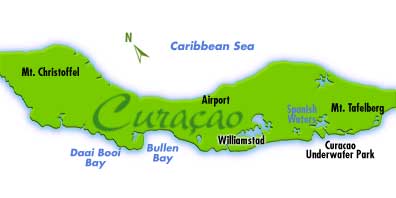 The Dutch have left their lasting mark on Curacao in many areas, but perhaps none as striking as the architecture. Nowhere else in the world outside of the Netherlands are there so many exquisite 17th and 18th Century Dutch colonial buildings. The Dutch have left their lasting mark on Curacao in many areas, but perhaps none as striking as the architecture. Nowhere else in the world outside of the Netherlands are there so many exquisite 17th and 18th Century Dutch colonial buildings.
Early settlers brought with them all their traditions, including their architecture and their notion of what made a proper home. In time, styles were modified to fit the realities of a dry and breezy climate by incorporating Caribbean influences such as verandahs, porches, fretwork and shutters -- and by adopting a palette of Caribbean colors undreamed of in Amsterdam.
Curacao is located in the southwestern Caribbean. The largest of the Netherlands Antilles, it is 38 miles long and from 2 to 7.5 miles wide. It is located just 35 miles north of Venezuela, 42 miles east of Aruba and only 2 1/2 hours by air from Miami. Curacao is outside the hurricane belt, making it a sure holiday destination for good weather.
Curacao Tourism Development Bureau
|
|
|
|
|
|
|
|
|
|
|
|
Architecture - Curacao
|
|
Punda and Pietermaai
The city of Willemstad dates from the Dutch capture of Curaçao by victory over the Spanish in 1634.  While the Spaniards had been content to erect simple stone dwellings, the Dutch began to fortify the island. Willemstad is divided in two by Santa Anna Bay. The oldest part, Punda ("The Point") is east of the harbor mouth. While the Spaniards had been content to erect simple stone dwellings, the Dutch began to fortify the island. Willemstad is divided in two by Santa Anna Bay. The oldest part, Punda ("The Point") is east of the harbor mouth.
One of the first permanent constructions was Fort Amsterdam which guards the entrance to St. Anna Bay, and became the focal point for the development of the city. Today, the Fort serves as the seat of the Government of the Netherlands Antilles. Along what are now Columbusstraat, Madurostraat and Handelskade ("Commerce Street") the up-and-coming Dutch Protestant merchants built their combined offices, warehouses, stores and living quarters. The basic layout of this area, with its narrow perpendicular streets, hasn't changed over the centuries. The first expansion of the city occurred about half a kilometer to the east, in the suburb of Pietermaai. Today the stately Pietermaai mansions are being restored as offices.
Otrobanda
The first building permits were granted for Otrobanda ("The Other Side" of the city), across St. Anna Bay in 1707. 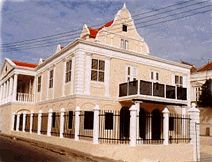 The buildings along Breedestraat were similar to those in Punda, with commercial space downstairs and living quarters on the upper floors. Off Breedestraat a grand residential neighborhood was built by those eager for stately mansions reflecting their higher social standing. These homes were often architecturally similar to the landhuizen (plantation houses) that were built around the same time. In contrast to the neat grid of Punda, Otrabanda is a maze of twisting streets and alleyways, giving the neighborhood its own intimate charm. By 1774, with 300 houses, Otrabanda was as big as Punda. In the 18th and19th centuries, free blacks began to migrate to the city. Some of the spacious Otrabanda yards were built over with more modest living quarters and small craft shops, forming the city's first working class neighborhood and urban center. By the 20th century Otrabanda had become a major cultural center for the rising black middle class. Many of the island's notable politicians, professionals, artists and musicians grew up here. The buildings along Breedestraat were similar to those in Punda, with commercial space downstairs and living quarters on the upper floors. Off Breedestraat a grand residential neighborhood was built by those eager for stately mansions reflecting their higher social standing. These homes were often architecturally similar to the landhuizen (plantation houses) that were built around the same time. In contrast to the neat grid of Punda, Otrabanda is a maze of twisting streets and alleyways, giving the neighborhood its own intimate charm. By 1774, with 300 houses, Otrabanda was as big as Punda. In the 18th and19th centuries, free blacks began to migrate to the city. Some of the spacious Otrabanda yards were built over with more modest living quarters and small craft shops, forming the city's first working class neighborhood and urban center. By the 20th century Otrabanda had become a major cultural center for the rising black middle class. Many of the island's notable politicians, professionals, artists and musicians grew up here.
Scharloo
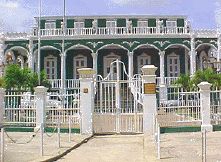 From the 19th century, The Sephardic Jews, who had emigrated to Curaçao after the fall of Brazil in 1654, built elegant Italian-style mansions in Scharloo, a former plantation just to the north of Willemstad. Reflecting the styles of the time, the Scharloo houses were built with neo -classical grace, with brighter colors and more intricate detail than their older counterparts. The typical U-shaped structure included a wide front gallery, a basement to protect the structure and its inhabitants from tropical storms, and a back gallery facing an open, Spanish-style patio. From the 19th century, The Sephardic Jews, who had emigrated to Curaçao after the fall of Brazil in 1654, built elegant Italian-style mansions in Scharloo, a former plantation just to the north of Willemstad. Reflecting the styles of the time, the Scharloo houses were built with neo -classical grace, with brighter colors and more intricate detail than their older counterparts. The typical U-shaped structure included a wide front gallery, a basement to protect the structure and its inhabitants from tropical storms, and a back gallery facing an open, Spanish-style patio.
Country houses
The island's landhuizen were built from as early as the 17th century. The style of the central house, known as the owner's house (kas di shon) was similar to that of the urban mansions in Otrobanda, often with the addition of large terraces in front and back. 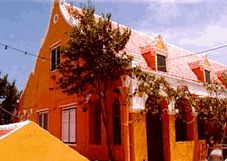 Domestic slaves lived in small stone huts near the main house; field slaves were allotted a small piece of land where they constructed their own little huts of branches, mud and straw. These rural houses ( kas di kunuku) were often named after the materials used in their construction like kas di yerba ( Thatch house) and kas di pal'i maishi (Sorghum Stalk House). After their emancipation in 1863 most former slaves continued to live in similar dwellings. Over the centuries most of these simple structures were reduced to mere rubble. The reconstructed Sorgum Stalk House Museum gives a feel for the rural life of bygone days. Their traditional architecture continues to influence Curaçao's contemporary architects. Modern buildings echo the shapes and forms of the past. The Public Library on The Waaigat is a fine example, as is the Curacao Marriott Resort & Casino. Domestic slaves lived in small stone huts near the main house; field slaves were allotted a small piece of land where they constructed their own little huts of branches, mud and straw. These rural houses ( kas di kunuku) were often named after the materials used in their construction like kas di yerba ( Thatch house) and kas di pal'i maishi (Sorghum Stalk House). After their emancipation in 1863 most former slaves continued to live in similar dwellings. Over the centuries most of these simple structures were reduced to mere rubble. The reconstructed Sorgum Stalk House Museum gives a feel for the rural life of bygone days. Their traditional architecture continues to influence Curaçao's contemporary architects. Modern buildings echo the shapes and forms of the past. The Public Library on The Waaigat is a fine example, as is the Curacao Marriott Resort & Casino.
|
|
Beaches - Curacao
|
|
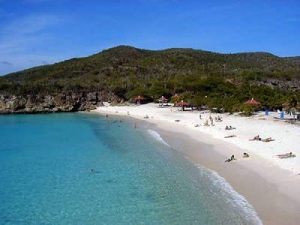 Curaçao has some thirty public and private beaches, ranging from intimate rocky coves to long strands bustling with activity. Almost all of the swimming beaches are scattered along the sheltered southwestern coast, where the waters are generally calm and crystal clear. The northern coast, with its powerful surf and strong undertow, is not suitable for swimming. Topless bathing is officially prohibited on all public beaches and some private ones, although tacitly accepted in some places. Curaçao has some thirty public and private beaches, ranging from intimate rocky coves to long strands bustling with activity. Almost all of the swimming beaches are scattered along the sheltered southwestern coast, where the waters are generally calm and crystal clear. The northern coast, with its powerful surf and strong undertow, is not suitable for swimming. Topless bathing is officially prohibited on all public beaches and some private ones, although tacitly accepted in some places.
Curaçao's waters are teeming with underwater life: multi-colored parrot fish, silvery barracuda, spotted French angelfish and colorful butterfly-fish are just some of the varieties you're apt to see. Colonies of coral and sea anemones inhabit the waters just off the shore.
|
Playa Porto Marie
|
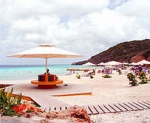 Playa 'PortoMari' is the place to be for All nature lovers.This long, enchanting stretch of sparkling white sand, with 'kid-friendly' waves is also a paradise for swimmers, snorkelers (equipment is available) and divers. The clear and quiet water of this natural beach has a unique 'double coral reef', that allows you to explore one reef, swim over it and soon encounter another, which makes it a fascinating dive site. The Seru Mateo, a hill near the beach, has an adventurous nature trail to the top, about 60 meters, with magnificent panoramas. Playa 'PortoMari' is the place to be for All nature lovers.This long, enchanting stretch of sparkling white sand, with 'kid-friendly' waves is also a paradise for swimmers, snorkelers (equipment is available) and divers. The clear and quiet water of this natural beach has a unique 'double coral reef', that allows you to explore one reef, swim over it and soon encounter another, which makes it a fascinating dive site. The Seru Mateo, a hill near the beach, has an adventurous nature trail to the top, about 60 meters, with magnificent panoramas.
The beach is open every day from 9.30 AM till 6.30 PM and the fun beachside bar and restaurant offers you a variety of delicious food.
Entrance fee is Naf. 3.50 (Naf. 4.â”Sunday/Holliday) including one free soft drink. Children under 12 years free.
|
|
|
|
|
Seaquarium Beach
|
 A full facility beach, this beach has palm trees and white sand. Ideal for children. It has a good selection of shops, bars, restaurants, and facilities for every imaginable water sport. Very busy on weekends, and the place to see and be seen. Topless sunbathing allowed. A full facility beach, this beach has palm trees and white sand. Ideal for children. It has a good selection of shops, bars, restaurants, and facilities for every imaginable water sport. Very busy on weekends, and the place to see and be seen. Topless sunbathing allowed.
|
|
|
|
|
Playa Kenepa
|
 These two beautiful coves are among the islands most popular beaches. Intimate Playa Kenepa has several shade pergolas set back from the water and a large snack bar. Behind the beach is a small salt marsh. In weekends, this beach is very crowded. Entrance is free. These two beautiful coves are among the islands most popular beaches. Intimate Playa Kenepa has several shade pergolas set back from the water and a large snack bar. Behind the beach is a small salt marsh. In weekends, this beach is very crowded. Entrance is free.
|
|
|
|
|
Cas Abao
|
 The Cas Abao Beach on Banda Abao has a white sandy beach, palm trees and parasols. It is ideal for swimmers, scuba divers and snorkelers. There is a restaurant and changing facilities, showers and toilets. A raft for sunbathing and playing is moored off the beach. The Cas Abao Beach on Banda Abao has a white sandy beach, palm trees and parasols. It is ideal for swimmers, scuba divers and snorkelers. There is a restaurant and changing facilities, showers and toilets. A raft for sunbathing and playing is moored off the beach.
|
|
|
|
|
Barbara Beach
|
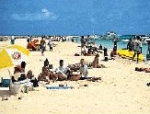 Full facility beach on Banda Ariba. Very suitable for children. Various facilities include a restaurant, showers, toilets and a bar. The beach is long enough for a leisurely stroll. On weekends the "Beau Monde" from Curaçao mores their yachts here to hang out and have a drink after taking their boats out to sea. Full facility beach on Banda Ariba. Very suitable for children. Various facilities include a restaurant, showers, toilets and a bar. The beach is long enough for a leisurely stroll. On weekends the "Beau Monde" from Curaçao mores their yachts here to hang out and have a drink after taking their boats out to sea.
|
|
|
Dining - Curacao
|
|
Curaçao has a large selection of international restaurants, with a wide variety of cuisine. A note on dress: beachwear is not appropriate except for beach bars and takeout, shorts and sandals for men are not acceptable at many places. Expect locals to dress very fashionably. Many restaurants are air-conditioned; you may want to bring a light jacket or coverup. Most restaurants add a 10% service charge beside the government 5% sales tax.. You may leave an additional tip if you are pleased with the service.
|
|
Diving - Curacao
|
|
Curaçao is ranked among the Caribbean's best islands for diving: the "Mushroom Forest" is one of the top dives in the world. Shore diving is rated with the best in the Caribbean, and the island has been called one of the top destinations for new divers.
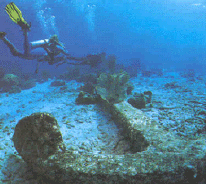 An arid climate, deep water close to the shore, distance from major sediment sources such as rivers, and painstaking reef conservation ensure that underwater Curaçao's pristine coral reefs remain home to a dazzling array of plant and animal life. Whether you are an experienced certified diver, a beginner or a snorkeler, our wide range of sites -- wall, reef, wrecks, even a "Car Pile" -- balmy water temperatures and excellent visibility (averaging about 100 ft.) provide an extraordinary experience for everyone. An arid climate, deep water close to the shore, distance from major sediment sources such as rivers, and painstaking reef conservation ensure that underwater Curaçao's pristine coral reefs remain home to a dazzling array of plant and animal life. Whether you are an experienced certified diver, a beginner or a snorkeler, our wide range of sites -- wall, reef, wrecks, even a "Car Pile" -- balmy water temperatures and excellent visibility (averaging about 100 ft.) provide an extraordinary experience for everyone.
Boat diving with a recommended dive operator is the most comfortable and luxurious way to dive Curacao, and for beginners with their Open Water Certificate, this option gives the greatest feeling of security. Many experienced divers prefer to head out and explore the numerous shore diving sites with their buddies. Most shore diving sites are easily accessible: with a good map of the island and a rental car, visitors can reach almost all sites in less than half an hour.
Curaçao is also home to the largest air station in the Caribbean, as well as two decompression chambers, one the largest in the Caribbean.
|
|
|
|
Deep Sea Fishing - Curacao
|
|
Coming Soon
|
|
|
|
Golf - Curacao
|
|
Coming Soon
|
|
|
|
Shopping - Curacao
|
|
Coming Soon
|
|
|
|
Watersports - Curacao
|
|
Coming Soon
|
|
|
|
|
|
|
|
|
|

|
|
Coming Soon!
|
|
|
|

|
|
Coming Soon!
|
|
|
|
|
|
|